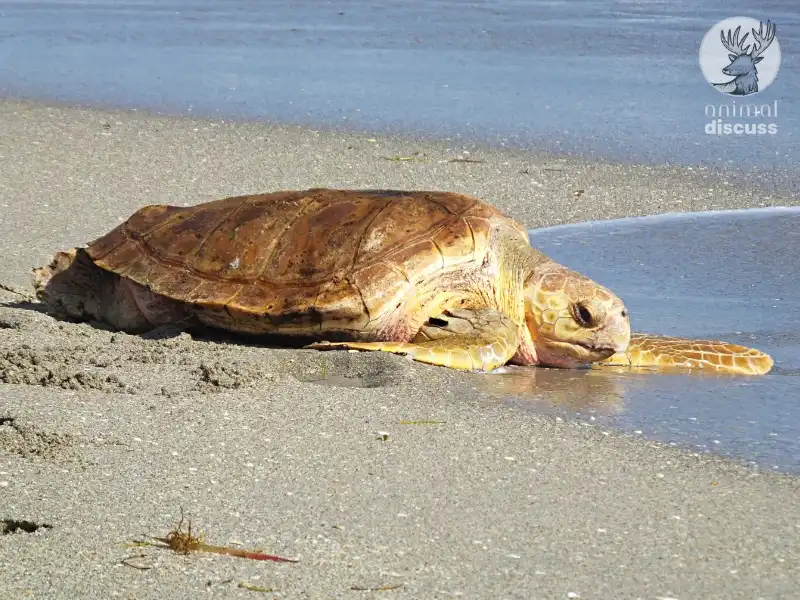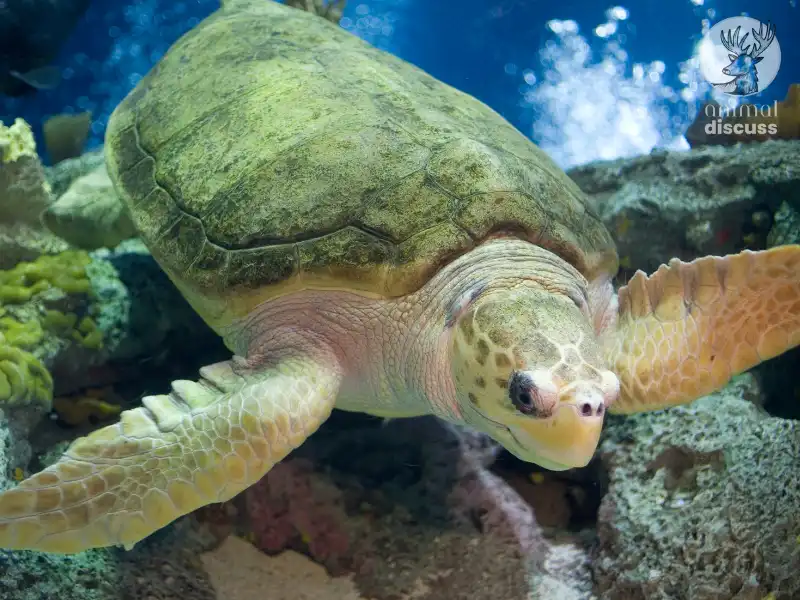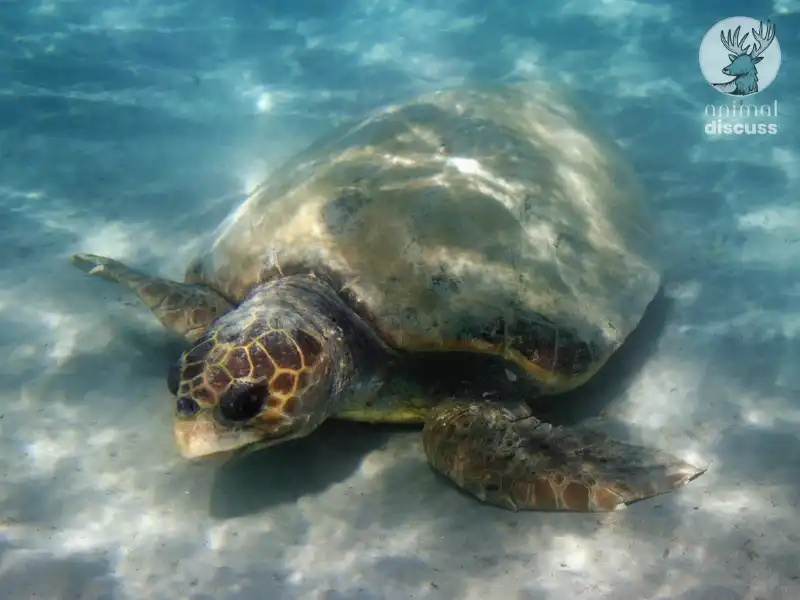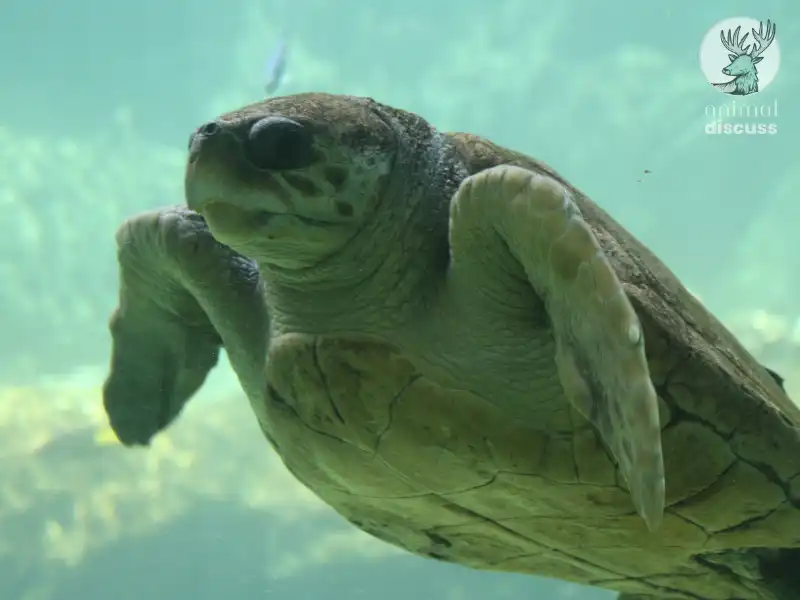Turtles are always fun to watch. But have you ever heard about loggerhead sea turtles? Well, this sea turtle is named so because of its large head in proportion to the rest of its body.
You can see them in abundant amounts in the United States. But what makes this species different from the other sea turtles? Well, its head, eating habits, habitat, nesting, mating habits, etc. are different from other ones.
I have discussed thoroughly about the loggerhead sea turtle details down below. Check it out to know details about them.
What Are A Few Characteristics of Loggerhead Sea Turtles? [Reference]
Beginning with loggerhead sea turtles’ unique features, their diversity contributes to the marine environment. They can stay alive for years after years, have colorful and heart-shaped bodies and many other characteristics.

Moreover, like snakes, they sometimes hiss too for communication. And in terms of their urination process, loggerhead sea turtles have an opening called a cloaca which lets them eliminate waste products. From this opening, their urine and feces come out from the body.
Other than all these they have many distinguishing features which are unlocked in the below table for your quick overview.
Have a look –
| Features | Facts |
|---|---|
| Scientific name | Caretta Caretta |
| Family | Cheloniidae |
| Communication way | Uses sounds like hissing and mostly uses body language like head nodding |
| Body Shape | Shell has a heart shape |
| Ears | Has an internal ear |
| Beak | Sharp for eating any lobsters, crabs, etc. |
| Size | 01. Male: 68-81 cm 02. Female:75-112 cm |
| Average lifespan | 70-80 years |
| Weight | 01. Male:54-113 kg 02. Female:77-159 kg |
| Egg production | Lays about four clutches which contain 100-120 eggs each |
| Tail | Adult males are differentiated through tails |
| Color | 01. The top shell of adults is reddish-brown 02. The bottom shell is more of a pale yellowish color 03. The neck and flippers are dull brown to reddish brown on the top. And the sides and bottom are paler yellow |
| Diet | Carnivores |
| Swimming speed | 01. Cruising speed: On an average of 1.4 to 9.3 km/h. 02. Burst speed: 22 mph |
| Habitat | Subtropical and temperate oceans of the world |
| Mating Life | Mates multiple in the breeding season |
| IUCN status | Endangered |
Where Do the Loggerhead Sea Turtles Live? (Reference)
Anywhere you look, you’ll see this loggerhead sea turtle. It is a resident of the Mediterranean Sea and the cold, subtropical, and tropical regions of the Indian, Atlantic, and Pacific oceans.
Keep in mind that while Loggerhead Sea turtles inhabit these vast regions, they are most active in coastal waters such as rivers, bays, and continental shelves.
Where an abundance of food is present. During migrations or specific life stages, such as when currents take young ones, they venture out to sea for the first time.
Moving on, just like other sea turtles, loggerhead sea turtles do not have any subspecies. However, because of their vast geographic range, the distinct population segments (DPS) of Loggerhead Sea turtles have formed unique features and genetic differences.
For example, the North Atlantic Ocean DPS of loggerheads is more in comparison to other populations. Here adults reach up to 3.5 feet in carapace length. You can see them primarily on the coasts of the United States from North Carolina to Florida. They are also seen in the eastern Gulf of Mexico and the Bahamas.
There are some other recognized distinct population segments which you see in detail in our “Where do Loggerhead Sea Turtles Live?”. Check it out if you are interested.
What Are the Behavioral Facts of Loggerhead Sea Turtles? (Reference)
Now, let’s talk about the behavioral facts of loggerhead sea turtles which will give you deeper insights about how they truly are.
In general, we know that most of the reptiles are not diurnal. But loggerhead sea turtles are! You can find them the most active in the daytime.

Even if they are kept in captivity, they will be seen spending their time swimming and resting at the bottom. But at night they are mostly seen resting and sleeping keeping their eyes closed.
Moving on, to their navigation skills. You will be amazed to hear that they are known as remarkable navigators! According to scientists, these turtles use a mixture of Earth’s magnetic field, and celestial signs like the sun and stars to travel thousands of kilometers.
But unfortunately, these creatures are more solitary than social. As without mating season you can see their minimal interaction with other sea turtles. Only if feeding areas are common do they seem to interact.
One fun fact which is witnessed about female loggerheads is they are seen to cry.
Yes! It’s a kind of special adaptation. Surprising right? The loggerhead has salt glands around their eyes which allows them to drink seawater and release the extra salt through it.
Then comes their nesting behavior. Well, the female loggerhead sea turtle has a behavior named natal homing. For this, they tend to return to the exact beach where they hatched before to lay their eggs.
Have you ever wondered how this loggerhead sea turtle communicates? Well, that is done through their body language. Different postures, movement of tails, nodding heads for aggression, etc. are their cues to socialize.
Even it is noted that sometimes they hiss and click for communication. Though it’s rare to find.
If you want to know more details about “behavioral facts of loggerhead sea turtle“, check out.
What Do the Loggerhead Sea Turtles Eat?
Loggerhead sea turtles are omnivorous which means they can eat both plants and animals. But their diet varies in terms of age and location. For example, the younger ones mostly eat floating organisms in the ocean like jellyfish, planktonic crustaceans, etc.

Whereas the adult loggerhead sea turtles mostly consume animal-based ones as they are carnivorous, like crabs, mollusks, etc.
If you want to know more details about what these loggerhead sea turtles diet, check out “Explaining the Food and Diet of Loggerhead Sea Turtles”.
How Do Loggerhead Sea Turtles Mate and Reproduce? (References 1) (Reference 2)
Every two to three years, loggerhead sea turtles mate in coastal waters. Here’s a short breakdown of the reproducing process of Loggerhead Sea turtles –
In the northern hemisphere, it normally occurs in late March to early June, and in the southern hemisphere, it occurs from October to March. They are seen mating in coastal waters. Not near the nesting beach. And their mating duration is short and quite aggressive, however, courtship is very minimal.
Most of the time it is noticed that male loggerhead sea turtles will circle around females or nuzzle their heads. Otherwise, sometimes males will gently bite the back of the female’s neck, or they will rear flippers.
Before the entire process, males are seen to compete. And the one who wins gets the chance to fertilize the eggs internally.
One interesting thing about them is they are able to store sperm from multiple males in their oviducts. As a result, at a time they get a chance to lead a multiple paternity in a single clutch of eggs.
What Are the Nesting Habits of Loggerhead Sea Turtles?
You can see a loggerhead sea turtle nesting every 2-3 years. However, this gap varies depending on their health and resources. And they are seen building this nest in their natal homing.
Loggerhead sea turtles start nesting at night when the surroundings are covered with darkness. Through crawling ashore, they start digging cavities in the sand through their flippers.

Around 3-5 clutches consisting of around 100 eggs are laid by them within a duration of several weeks. After laying, they cover the nest with sand and then return back to the ocean.
You know what? They can determine the sex of the hatchlings through the incubation temperature. When the temperature is warmer in the sand, it gives birth to more females. Whereas the cooler temperatures propagate the chance of more male birth.
At night in the nest hatching starts. After that, they crawl towards the sea using the light of the moon and stars. For 46-80 days in the warm sand, the eggs of the loggerhead sea turtles remain incubated.
However, these loggerheads who are in the early stage are quite vulnerable to predators like birds, crabs and fish. Only a few can manage to enter adulthood.
What Are the Natural Predators That Eat Loggerhead Sea Turtles?
Now, I will talk about the enemies of loggerhead sea turtles, who are threatening their different stages of life. Beginning with the time when they are eggs or just hatchlings. On land, mostly the raccoons, crabs, fire ants, and birds are their attackers.
Through digging or attacking they kill those younger ones. And in sea areas, large fish like sharks consume them too.
Other than that, when they are adults, sharks like tiger sharks attack the heads or flippers of these turtles. Through causing injury, they cause death to them.
What Challenges Do Loggerhead Sea Turtles Face?
These wonderful creatures are sufferers of different challenges. For this, they are labeled in a vulnerable stage on the IUCN Red List of threatened species. Here are some of the most significant threats loggerhead sea turtles face.
Construction of buildings and resorts near the sea destroys their nesting beaches and changes shorelines. Moreover, different pollutants like plastics and oil spills contaminate the nesting beaches and the grounds of feeding. It directly hampers the turtle’s health and food sources.

Even when there is an overflow of sea levels, it disrupts the nesting beach and their temperature-dependent sex determination. Thus, it hampers the sex ratios for the upcoming generation.
Likewise, nets and longlines become the reason for their major death, especially the younger ones. Besides, when there is a collision of boats, it becomes an unwanted reason for the injury or death of the turtles.
Other than that, ingestion of plastics and debris, and thinking of them as food creates their internal injuries too. Accordingly, illegal hunting, egg collection and diseases like fibropapillomatosis make it harder for loggerhead sea turtles to survive.
What Are the Conservation Efforts Taken for Loggerhead Sea Turtles?
You’ll be happy to hear that numerous efforts are being considered to protect them. Let’s have a glance at them to have a clear idea about it-
- Protection of habitat: Different steps are taken into consideration to conserve nesting beaches. Damaged areas are being restored and coastal development impacts are minimized too.
- Modifications of fishing gear: In order to reduce bycatch, research and development is done to make a few turtle-friendly fishing gear.
- Distributing awareness campaigns: It is high time that people become aware of the threats these small creatures are facing. For this, public education programs aim to bring awareness and encourage responsible attitudes towards them.
By supporting these efforts and making wise steps, we can make a vital step to ensure the survival of these sea creatures from extinction away from our planet.
Frequently Asked Questions
Here are the interesting segments that will clarify a few of your asked questions that I have not yet discussed.
01. Can loggerhead sea turtles eat hard-shelled prey?
Yes, they can. As they have strong jaws that let them break hard-shelled prey like conchs and whelks easily.
02. How long can loggerhead sea turtles hold breath underwater?
They are able to hold their breath for longer periods. For about 4 to 7 hours, they can do it while resting. They conserve oxygen by holding their breath and heart rate also significantly slows down.
03. What are the adaptations of a loggerhead sea turtle?
For millions of years, this sea turtle has been surviving in the ocean. Through adapting beak-like mouthparts, it has been allowed to do so.
04. Can you keep loggerhead sea turtles as pets?
Unfortunately, no. Because these sea turtles’ habitats cannot be created in a homely environment. Moreover, their diet, health and nothing will allow them to stay in a confined space.
Conclusion
Well, this is it. I am done with the detailed overview of this amazing creature who has remained alive for years! The strong beak adaptation and the ability to conserve energy have allowed this slow and steady creature to survive for so long.
You have learned till now how they are thriving every day to survive. Let’s be cautious and make awareness viral so that they can remain alive.

